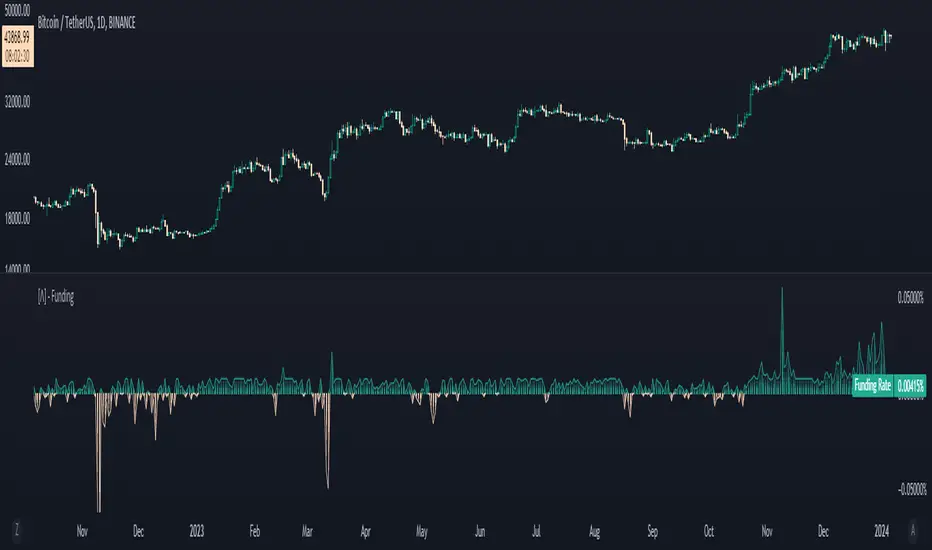PROTECTED SOURCE SCRIPT
업데이트됨 Aggregated Funding Rate

This funding rate indicator combines data from two of the largest cryptocurrency exchanges, BitMex and Binance, and supports USD, USDT, and BUSD currency pairs. Moreover, it covers a wide range of 31 different crypto assets to choose from, providing users with a comprehensive view of the funding rate for each asset.
The aggregation is formed by calculating the funding rate of the cryptocurrency for each perpetual chart respectively (Binance - USDT & BUSD and BitMex - USDT & USD). The calculation itself is based on each exchange's official formula, hence the reasoning behind including only 4 sources, they are currently the only ones which can be calculated this way in Tradingview.
Afterwards, it is either summed or averaged based on the user input. Additionaly, the user may choose freely which of the four sources will be included.
What is Funding Rate ?
The funding rate is the cost of holding a cryptocurrency position on a futures exchange. It is essentially an interest rate paid by the long or short position holder to the counterparty. If the funding rate is positive, longs pay shorts, and if it is negative, shorts pay longs. This rate is adjusted periodically, typically every eight hours, to ensure that the futures price of the cryptocurrency remains close to its spot price.
Utility :
The funding rate indicator can be used in a variety of ways. Traders can use it to gauge the sentiment of the market. If the funding rate is consistently positive, it suggests that there is more demand for long positions than short positions, indicating that the market is bullish. On the other hand, if the funding rate is consistently negative, it suggests that there is more demand for short positions than long positions, indicating that the market is bearish.
In addition, the funding rate indicator can be used to identify potential trading opportunities. If the funding rate is significantly higher than usual, it may indicate that longs are overpaying shorts, creating a potential arbitrage opportunity. Alternatively, if the funding rate is significantly lower than usual, it may indicate that shorts are overpaying longs, creating a potential arbitrage opportunity in the opposite direction.
Key Features
The aggregation is formed by calculating the funding rate of the cryptocurrency for each perpetual chart respectively (Binance - USDT & BUSD and BitMex - USDT & USD). The calculation itself is based on each exchange's official formula, hence the reasoning behind including only 4 sources, they are currently the only ones which can be calculated this way in Tradingview.
Afterwards, it is either summed or averaged based on the user input. Additionaly, the user may choose freely which of the four sources will be included.
What is Funding Rate ?
The funding rate is the cost of holding a cryptocurrency position on a futures exchange. It is essentially an interest rate paid by the long or short position holder to the counterparty. If the funding rate is positive, longs pay shorts, and if it is negative, shorts pay longs. This rate is adjusted periodically, typically every eight hours, to ensure that the futures price of the cryptocurrency remains close to its spot price.
Utility :
The funding rate indicator can be used in a variety of ways. Traders can use it to gauge the sentiment of the market. If the funding rate is consistently positive, it suggests that there is more demand for long positions than short positions, indicating that the market is bullish. On the other hand, if the funding rate is consistently negative, it suggests that there is more demand for short positions than long positions, indicating that the market is bearish.
In addition, the funding rate indicator can be used to identify potential trading opportunities. If the funding rate is significantly higher than usual, it may indicate that longs are overpaying shorts, creating a potential arbitrage opportunity. Alternatively, if the funding rate is significantly lower than usual, it may indicate that shorts are overpaying longs, creating a potential arbitrage opportunity in the opposite direction.
Key Features
- Aggregation type
- 31 supported cryptocurrencies
- Simple or Depth style options
- Sources to aggregate
릴리즈 노트
Added 릴리즈 노트
Fixed Error보호된 스크립트입니다
이 스크립트는 비공개 소스로 게시됩니다. 하지만 이를 자유롭게 제한 없이 사용할 수 있습니다 – 자세한 내용은 여기에서 확인하세요.
면책사항
해당 정보와 게시물은 금융, 투자, 트레이딩 또는 기타 유형의 조언이나 권장 사항으로 간주되지 않으며, 트레이딩뷰에서 제공하거나 보증하는 것이 아닙니다. 자세한 내용은 이용 약관을 참조하세요.
보호된 스크립트입니다
이 스크립트는 비공개 소스로 게시됩니다. 하지만 이를 자유롭게 제한 없이 사용할 수 있습니다 – 자세한 내용은 여기에서 확인하세요.
면책사항
해당 정보와 게시물은 금융, 투자, 트레이딩 또는 기타 유형의 조언이나 권장 사항으로 간주되지 않으며, 트레이딩뷰에서 제공하거나 보증하는 것이 아닙니다. 자세한 내용은 이용 약관을 참조하세요.